#flexible antenna
Explore tagged Tumblr posts
Text
0 notes
Text
DJI Launches Lightweight Commercial Video Transmission with Advanced SDR Technology - DJI SDR
DJI, the world leader in creative camera technology, has unveiled a revolutionary video transmission system featuring advanced software-defined radio (SDR) technology. Aimed at small to medium-sized film crews, the DJI SDR Transmission system promises enhanced stability, superior interference resistance, and robust penetration capabilities. It also supports simultaneous Wi-Fi transmissions for…
#1080p#20Mbps#3km range#60fps#accessible#antenna#aperture#ARRI#Australia#broadcast mode#cinema cameras#collaboration#creative camera#creative tools#DJI#DJI RS 3 Pro#DJI RS 4#DJI RS 4 Pro#DJI Store#film industry#filmmakers#Flexibility#Force Mobile#gimbal#HDMI#interference resistance#ISO#launch#Lightweight#metadata
0 notes
Text
i haven't said it before but why is it still the neighbour's cat and not your cat
how to stop neighbour cat from loving me so much so I can use computer
#also as a person with own cat who loves me too much to let me use the computer#see if you can get one of those cat toys that are basically a handle + a long and flexible antenna (? wire?) with a dongle at the end#stick the handle in your waistband or pocket when you sit down so that the dongle dangles behind you and wiggle in place#cat will play at your back and let you have keyboard access
512 notes
·
View notes
Text


struck by the urge to draw Patches again but also work out how much of a Megasphinx sp. general silhouette is just aerodynamic contour scales (wings shrunk to save canvas space)
the 3rd pair of legs emerge from the thorax. my mild pet peeve when ppl design insects that walk upright/on the rear legs (not anthros but actual speculative designs) is leg attachment.. for these guys i put in elongated coxa proximal to the femur which adds an extra swivel to the leg so the 'knee' (joint between femur and tibia) can point forward for bipedalism and backward for hexapod movement. 'upright' is not a normal stance for them (they prefer hexapod stance) but sometimes you have to hold onto stuff in your hands and walk at the same time. the abdomen dragging on the ground is not actually an issue, it is really flexible and curled aloft when walking upright
also made it more obvious that the maxillary palps point up and form the 'nose'. chemoreception is handled by the antenna (in Sphingidae, males do not possess feathery antennae) and, in males, setae at the tip of the abdomen. the scales are somewhat stiff to the touch, they feel a bit like hair that has been gelled into place. they are convergent with contour feathers and extremely light, adding almost nothing to the body weight while working well to manage heat and make a streamlined shape. although Megasphinx sp. are not warm-blooded, they need a high core temperature to operate their wing muscles. if it's cold out, they'll sit around doing the equivalent of revving their muscles with their wings in neutral gear, producing enough warmth to allow flight. if it's too hot out, the scales can open up to allow air to reach the back of the thorax
the scales do partially cover the spiracles, which are used for gas exchange, but this does not affect breathing on Thera. Megasphinx sp. has a negative-pressure respiratory system unlike the passive air intake of other Sphingids and small insects, and can actively inhale. This is a necessity due to their large size but also because if they wanna go to Earth, the oxygen % in the air is far lower than what they would expect at home, and without strong breathing abilities they can become hypoxic. Flight is impossible on Earth for this reason and Theran visitors are known to trim or clip off scales occluding the spiracles in the belief that it might help the persistent feeling of breathlessness
#hi i was consumed by a temporary madness and had to draw my beautiful insect vampire again#setting: thera#<- i'll get back to u some day bby ilu
1K notes
·
View notes
Video
youtube
flex pcb fabrication 2023 3
#youtube#flex.pcb.fabrication.2023.3.mp4 single layer and double layer flexible flex PCB manufacturer fast flex prototype shenzhen China antennaIC ca
0 notes
Text
Finally finishing all these guys we’ve got charts and headcanons! (Long post)

(Height)


(Wingspan)

(Body length & basic shapes I used) (it might be odd but ignore any detail on the back, the shapes are for general body shape)
Headcanons:
Seawings: - Colors range from red and purple to yellow - Aquatic is based off areas of bioluminescence rather than singular scales (because no one wants to draw all of those) - Although they average small compared to the other tribes, gigantism is more common - Wing bioluminescence gene is always present but for some doesn't show, thus aquatic doesn't utilize the wings
Rainwings: - Can change the texture of their scales alongside color - Weakest bite due to their fangs, probably why they're vegetarian - Mimic interesting behaviors - Have forked tongues
Mudwings: - Colors range from olive green to purple-ish red - Very resilient - Able to breathe fire regardless of body temperature, the heat of the flame depends on body temp - Their horns constantly grow and sometimes have to be cut due to dangerous growing patterns - Love gnawing on things, tough foods like jerky is popular - The horn covers of fallen siblings are harvested and turned into instruments to remember them by
Leafwings: - Colors range from gold to teal (and pink to olive green during cold seasons) - Can appear to have false eyes - Bug-like just like the other Pantalan residents (because they're just some weird outlier like what is going on here) - Leafspeak doesn't actually allow them to hear voices from plants but rather increase the sensitivity of their antennae which pick up on the changes in plants - In colder seasons, regions that have deciduous trees influence leafwings in that their scales change into warm tones similar to fallen leaves for camouflage but this also negatively impacts one's leafspeak ability; this doesn't apply to evergreen leafwings however
Hivewings: - Colors range from hot pink to olive green - Can appear to have false eyes - Have elbowed antennae just like their "cousins", Hymenoptera (wasps, bees, ants) - Tend to disregard personal space/get close out of habit, being close means better temp regulation and better communication - All hivewings have stingers, wrist stingers, and a venomous bite but it largely depends on preference of which they choose and like muscles, they can be exercised to become deadly weapons - They're not capable of "emitting a horrible stench"
Icewings: - Colors range from white to pale indigo - Melanism is still very rare but more likely in icewings - Can be iridescent in any color, especially visible in lighter scaled individuals - The scales on their face is very fine and is flushed with blood which darkens the area and allows them to see in the snow by absorbing light, otherwise the glare from the sun reflecting off would be a hinderance - Their wings are thin and thus have visible veins most of the time - Idk how to describe their scales other than its kinda like basalt formations - From the side they appear large but are actually thin and flexible - They can freeze to death if they've gone without cold for a long time and then reintroduced too quickly - In hybridization, they have dominant genes, partially because the animus gene - The extra mane of horns can appear randomly on the body in singular spikes, they also make a clink sound when they collide as if they're made of ice, making a pretty scary rattle when disturbed
Nightwings: - Colors range from orange to purple - Albinism is still very rare but more likely in nightwings - Dwarfism is more common - Teardrop scales are always present, highlighted when the dragon has powers regardless of type - Pitbull ready to bite kids - They CAN hang upside down as the books suggest but not for long - By taking dust baths, they dull their scales to reflect less light and blend in better in the dark - Have white fire but cant breathe for long due to how hot it is (this is mainly to add onto the mysterious factor of em and I always liked the idea) - Due to eye sensitivity, they hate sudden bright lights and will close their eyes as they breathe fire
Silkwings: - Can have black or dark accents but never as a whole body color unless they've hybridized - Wing shapes vary widely - Can appear to have false eyes - Flamesilk is rarer than one might think - Very flexible and have strong tails used as a sort of 5th limb in climbing - Albino or melanistic dragons still keep their iridescence - Silk is emitted through a spinneret on the chin rather than the wrists - Prefer to travel in pairs (instinct)
Sandwings: - Colors range from red to olive green - Dark patters often mimic a snake's - Horse-like in complexion - Alongside their snake-like appearance, they have pit organs - Tend to move like birds - Poor eyesight but good hearing - Their horns angle upwards sort of like a bull
Skywings: - Colors range from red to yellow (and green because skywings are meant to be your typical fire breathing dragon which is most often depicted to be red but can also be green) - Tend to move like birds - Weaker than they appear - Green skywings are incapable of being or having flamescales - Their horns constantly grow and have to be filed down - A flamescale cant melt rock or metal by touch alone, only via fire is it possible - It's not that they don't want flamescales that they kill them, it's more of a mercy killing because of how lonely their life can be
#myart#wings of fire#wof#wings of fire seawing#wings of fire mudwing#wings of fire skywing#wings of fire nightwing#wings of fire icewing#wings of fire silkwing#wings of fire sandwing#wings of fire hivewing#wings of fire rainwing#wings of fire leafwing#dragon#wof seawing#wof mudwing#wof skywing#wof nightwing#wof icewing#wof silkwing#wof sandwing#wof hivewing#wof leafwing#wof rainwing
3K notes
·
View notes
Note
I get the feeling NSH used to have much more flexible antenna and then did something really dumb and they were rendered the way they are today
I've seen some people with the headcanon that he wrecked, cut or removed his antennae! I'm leaning on my NSH just being made that way though. There are other iterators with similarly short antennae, or even no antennae at all.
He doesn't seem to be all too bothered by it in the end. Especially when it leads to opportunities like this...
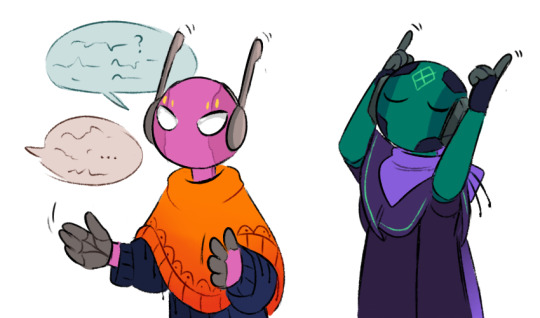
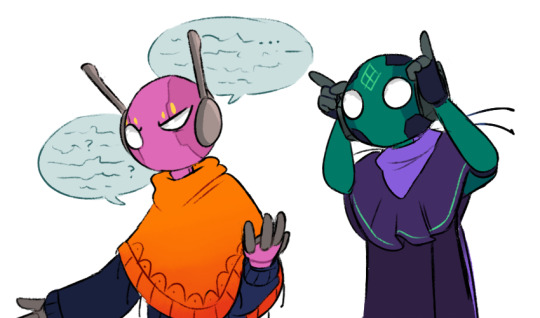
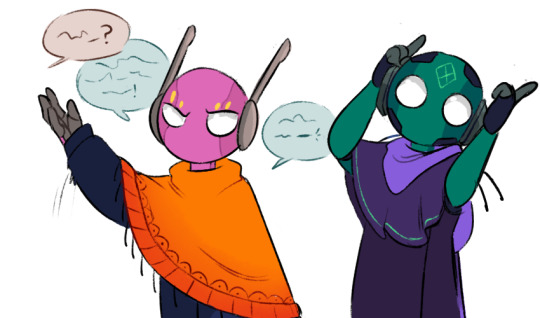

#so much five pebbles tonight#i headcanon that pebbs gesticulates a lot when he gets deep into a rant/conversation :)#rain world#five pebbles#no significant harassment#ask#anon#flickerdoodles#art
2K notes
·
View notes
Text
Some Headcanons about Pantala because AAAASNMSKAKAMA
The mountain range of Pantala is said to be cursed because of the mysterious ruins there, which Wasp destroyed all evidence of. This is because they held the BeetleWing palace. It is generally avoided because of this and because of the extremely harsh conditions.
SilkWings can be (almost) cleanly separated into the more moth-like SilkWings (thicker build, floofier, slightly duller scales, larger wings, but smaller overall) and more butterfly-like SilkWings (slimmer, longer antennae, less flexible wings, curled claws, MUCH flashier colours).
HiveWings aren’t all descended from ClearSight: when ClearSight saved everyone, BeetleWings started trying to have dragonets with more black scales as a tribute to her. The only HiveWings really descended from ClearSight are the royal family: the idea that all HiveWings are her family is (VERY) old propaganda to make HiveWings seem superior.
LeafWings have a weaker version of RainWing photosynthesis.
#i’ll finish this later#wof#wings of fire#headcanon#wof headcanon#wof analysis#wof thoughts#wof theory
206 notes
·
View notes
Note
About Shargon: What kind of compound are their horns made of? Is it the same as his teeth or skeleton? What’s the reason behind their glow? I think it’s really cool so I thought I’d ask
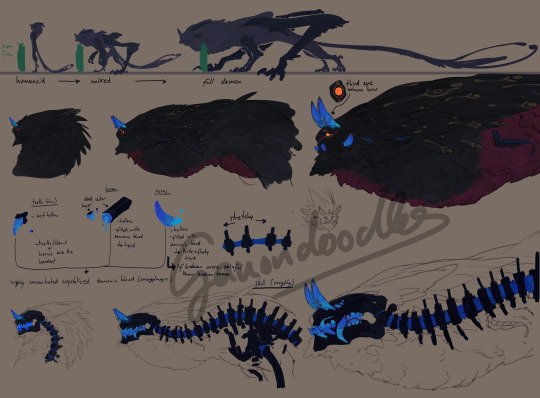
Thank you for the ask!
so, alot of demon anatomy revolves around their demonic heart and its blood (which is concentrated energy/magic- the color of which is determined by their elemental type, Shargon is type lightning, which is generally a mid blue going into greenish, but there are always slight color variations even between the same types) their bones too are made of crystalized demonic blood, its coated in a black layer of depleted blood (so the substance without energy) that acts as a sort of armor and makes the bones more durable and able to withstand even alot of bending (when a demon shape shifts their bones have to decrystalize to some extent to shift into different forms and sizes, its really uncomfortable or even painful depending on how well trained they are or in stressful situations since that process is something that needs to be done right or they end up really messy and vunerable) bones are also hollow and filled with demonic blood, it also aids their flexibility and the shapeshifting process and makes sure that if one is broken its quickly healed again since the bone doesnt have to decrystalize first
teeth and claws are not hollow and lack the black layer bc it eases using magic/energy through them and makes them harder to break, unlike the bones they are as hard as possible instead of flexible; the liquid blood isnt necessary since a broken tooth or claw usually gets discarded entirely and regrown from the ground up
horns are a mix of both, they dont have a black layer but are hollow (at least partly through) and filled with an even more concentrated version of demonic blood, very similar to heartblood (only found in the heart, the most concentrated version with a similar consistency; like a thick floaty liquid) and connected to it (you could see or feel a pulse in Shargons horns) but it lacks the genetic information actual heartblood carries- horns act mainly as a sensing aid ... like antenna in a way, or how whales melons work, it aids in sensing energy nearby, navigation, limited long range communication or if an energy wave that was sent out has hit something like a living demon .. or a dead one if theres still some remaining energy left (works best between demons of the same elemental type, but isnt limited to them and also depends on how skilled or mighty a demon is- for example, Eadrya, type water but extraordinarily powerful, could sent out even a really weak energy wave and they would be able to sense if it hits Shargon while Shargon himself might just feel there was some energy, but not from who or what type) and can pick up frequencies of distress calls that have lost the hearable part
the downside to that is if a horn was to break it might actually be the most painful thing to happen to a demon, even worse so if it draws blood, its like stabbing the most sensitive nerve that goes through their head and spine and heart, depending on the severity of the injury it might be paralyzing or drive a demon temporarily mad- worse than a stabwound into the heart itself
not all demons have horns, they are a very diverse kind of creatures that are each built better for different things (Eadrya doesnt have horns, the extreme amount of energy at their disposal pretty much closes any gap horns could have made in aiding senses- an advantage being less vunerability, a downside though is easy disturbance of anything relating to those senses by other energy types or frequencies .... and a general downside to Eadryas .. overproduction of magic even, is being basically the most detectable demon in the world due to them constantly emitting energy at very high levels if they are in good health)
(since Shargon (he/they) is the main example here, hes a demon that is built for speed and flexibility, for quick strikes out of the shadows, his bones are thin and bendable, his teeth are long, sharp and angled in various ways so if he bites he can lock it down hard without escape, even if the force of his bite isnt the strongest in itself- he can turn his head fully around multiple times (like an owl but worse) and his throat is largely made of pure muscle (the most muscle on him is his throat and to the big primary arms) perfect to bite and pull and twist until whatever he bit into gives out, getting him off of something is rather impossible without doing massive damage to it in the process (unless he lets go willingly of course)
-since i compared him to Eadrya (they/them) already- they are quick but only in water, their sheer size, thick skin, bones and well, body is really hard to damage, their teeth are small and all in the same shape in two rows on both sides, their maw is really wide and their bite force is pretty strong- if they bite it is with the intent to bite clean through, if that doesnt work they would need to let go and go for it again here older art but just to give you a general idea for Eadrya (demon form):
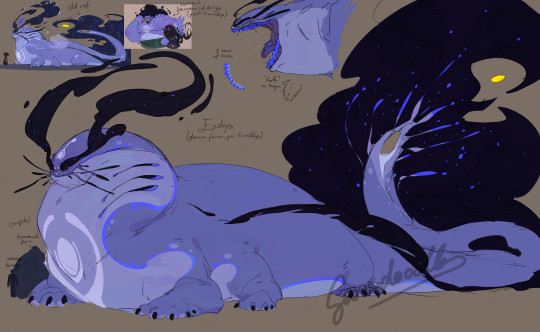
Thor (any pronouns) is another one that is really different- they are massive and armored with thick, hard plates, they are slow and have little mobility but are nigh impossible to take down unless you know exactly how; they dont have alot of teeth, rather small and probably not very sharp either and due to her two big tusks going forward its rather hard to actually get to anything to bite into, if she were though it would be somewhat akin to alligators (i think) that just smash their massive bones together to break whatever is in between with little to no actual 'biting' going on
(rather outdated art that i still, somehow, like- her humaoid form:

and an even MORE outdated ancient doodle of her demon form:

the only somewhat accurate part is the general shape and head, though the mouth isnt accurate anymore either ... barely anything is but something is better than nothing and the roughly lobster inspired design idea is still currently the idea)
OC lore ramble over :3
#ganondoodles answers#ganondoodles#art#original art#concept art#original characters#oc#ocs#oc lore#monsters#............unless i keept talking in the tags#another reason to why shargon is so good ... so much better at shape shifting quickly and even able to have intact mixed forms#might also be bc of his high pain tolerance- shapeshifting is or can very easily be painful#considering they have to .. liquify their bones to do it#and shargon is so used to pain his tolerance is high and he just .. does it anyway#which is probably not what the other demons expect to be the reason#... i keep worrying im making shargon really unlikable bc of all the shit hes been through#but also thats essential to his character#depressed abused and rejected from society demon with a special interest in humans and their world#i really need to study skull anatomy so i can make a better one at some point ... in the far future probably given how slow i am#forgive any weird spelling or something im not feeling well due to the migraines and am also extremely tired#...bc it takes me hours to write and draw anythign i guess#adding alt text tomorrow bc at least on tumblr you can add that later too
141 notes
·
View notes
Text
#3dbi PCB flexible#2.4ghz 5ghz antenna#pcb flexible antenna#rf antenna price#rf antenna amplifier#rf antenna manufacturers in india#5g antenna
0 notes
Text
Dragons of Pantala (headcanon designs)
• Silkwings:

-Inherited from nightwings genes of fur on the chest and in their case they only progressed, thanks to which the wool is distributed throughout the abdomen, neck and front legs
-In addition, the shape of the scales is more like the scales of nightwings than the beetlewings. The hind legs are also inherited from nightwings (in general, silkwings closer to the nightwings while hivewongs to the beetlewings)
-Big Eyes
-Very long tongue
-Mouth are small and round
-Short, round ears
-Teeth are not very sharp, by structure more like the teeth of herbivores than of predators (transitional form from one diet to another; such a structure also came from the merger of nightwings (predators) and beetlewings (omnivorous, but preferring to eat plants; fed only under adverse conditions))
-Blood are beige, semi-transparent
-The shape before and after Metamorphosis is significantly different. The "caterpillars" (before metamorphosis) are covered with blistering scales, some have a greenish tinge, developed a cusptry at the mouth - the mouthparts helps the dragonets to feed (after metamorphosis only small mouthparts remain, which are rather rudimentary), very small antennae on the head, almost not functioning; their role replaces temporary growths on the lower jaw, which disappear after metamorphosis. Body consists of scales, fur missing
-After metamorphosis the skin color becomes much brighter, grow long antennae with fur at the end, also appears directly, the fur itself on some parts of the body
-The shape of the wings in some individuals may be different (similar to the butterfly wings after which they were named)
-Flamesilk dragons have patterns in the form of lights on their wings and also fire colors (red, orange, yellow) all over their body. Eyes are also very bright (before the metamorphosis it is not visible, also in normal silkwings eye color changes slightly, unlike flamesilk dragons). All this is a warning to other creatures that these dragons don't have ordinary silk (it is similar to how in our world poisonous animals have bright, warning coloring)
-Growth reaches 2-2.5 meters
*The design was based on butterflies and their caterpillars

• Hivewings:
-Round tail. Despite its external fleshiness, it is almost completely hollow and not overloaded with internal organs and muscles. It contains only organs of the reproductive system and a reservoir with poison. And even though there are these organs that contribute to the flying, 2 pairs of wings and a dense front of the body all compensate for it, and they restore balance
-The tail itself is motionless, only able to descend, in order to wound the opponent with a dagger. The front part of the body is more flexible.
-Ears are long but thin
-Blood as like silkwings, beige and semi-transparent, but has a darker shade
-The gait is more developed than silkwings
-Paw structure identical to beetlewings
-Thorns on the entire spine fall long, with a sharp end
-Horns are curved, facing the opposite direction
-Whites darkened but not entirely black, has a dark shade of the color of the iris
-Also prefer to eat plants, but unlike silkwings, their teeth are very sharp. The reason is defensive functions, the presence of poison in them.
-Mouth is sharp, triangular shape
-Growth reaches 2.5-3 meters
*The design was based on bees, wasps and some other insects
• Beetlewings:

-Horns curved and parallel to the mouth
-Sharp nose, able to pierce the opponent
-The mouthparts, which due to the long nose is necessary for beetlewings so that from the mouth as little food as possible. The long tongue also helps (but it is less than the silkwing's tongue)
-2 pair of wings: the first is twice as short as the second, it performs the role of elytra
-The second pair of wings can fold and hide under the first
-Double thorn on the tail. The structure of the tail is similar to the tail of hivewings (the tail of the beetlewings is longer than that of the hivewings)
-Large thorns on the spine
-Semi-transparent beige blood
-Whites are also darkened, but not as much as in their descendants, hivewings
-Ears are pointed but not very long
-Omnivores
-Growth reaches 2.5-3.5 meters
*The design was based on bugs and some other insects
• Leafwings:

-Horizontal eye shape
-The presence of a modified ruffs (they are related to rainwings)
-Wings, webbed spines, ruffs and ears are leaf-shaped, and they can be very different in each individual (often their appearance resembles the plant after which they were named)
-Their scales do not necessarily have a green tint in all individuals
-Long, multi-ended horns that resemble tree branches. Many bigger than rainwings
-Paw structure almost identical to rainwings
-Sapwings and poisonwings try to distinguish themselves by applying paint on small fragments of scales, often making a small pattern from this (the first are painted in pale colors, the second, on the contrary, in colorful, mostly consisting of red, yellow and orange shades)
-In addition to this poisonwings can sharpen their webbed spines and horns, make them sharper
-Height reaches 3-4 meters
*The design was based on trees, their leaves and partly rainwings
#wof oc art#wof art#wof#wof silkwing#silkwings#silkwing#wof hivewing#wings of fire hivewing#hivewing#hivewings#wings of fire headcanons#wings of fire silkwing#wings of fire art#wings of fire#wof beetlewing#beetlewing#leafwing#wof leafwing#leafwings#wings of fire leafwing#wof drawing#wof dragon#dragon art#artists on tumblr#my art#art#artwork#dragon#digital artist#wof headcanon
200 notes
·
View notes
Text
#5G 10dBi Flexible antenna#flexible round shape antenna#5g round shape internal antenna#ufl connector#rf antenna#5g technology#5g antenna#4g antenna#internal antenna#pcb antenna
0 notes
Text



Next round of Firebird's Roost character sheets! Here we've got Luther and Wisp, the diligent keepers of the Magma Sanctum, and Forgemaster Moloch, who might find himself in unexpected need of the magister's services...
Design notes under cut:
LUTHER
-Usually keeps his pearl on a shelf in the sanctum instead of carrying it
-Jacket has two narrow slits in the back for his wings to poke through
WISP
-Highly expressive and flexible antennae
-Prefers to walk/stand in the position shown, with six legs on the ground and the front four used to gesture or hold objects
MOLOCH
-Wings and mane are fluid, similar to Wraith's, but have a much thicker texture and tend to hold their shape fairly well
-Hard, segmented body (Wasp gene)
-Prosthetic claw and tail glow bright orange
#flight rising#firebird's roost#mask art#luther the pearlcatcher#fr pearlcatcher#wisp the everlux#fr everlux#moloch the obelisk#fr obelisk#frfanart
97 notes
·
View notes
Text
Wet Beast Wednesday: krill
The ocean is a huge place and food can be sparse. While the ocean receives plenty of energy in the form of sunlight, that energy needs to be converted into a form animals can consume. This is a job that krill have adopted with gusto. These little shrimpy critters live all over the world and play a vital role in the cycling of energy and nutrients. Krill are among the most common and important marine species, but many people overlook them or think of them as nothing but whale food. let's take a dive into the world of krill to show you that there's more there to appreciate.

(Image: a side view of an antarctic krill. It is a shrimp-like animal divided into a solid cephalothorax and flexible abdomen. On one end of the cephalothorax are the eyes and antennae and on the underside are multiple pairs of thin, feathery legs and gills. Along the segmented abdomen are paddle-like appendages. The tail is fanned out. The body is translucent with spots of red pigment. The cephalothorax looks green due to the presence of algae in the stomach. End ID)
There are 86 known species of krill in the order Euphausiacea. While they look a lot like shrimp or prawns, Euphausiacea is actually a sister group to Decapoda, which contains the shrimp, prawns, and most other crustaceans you've heard of. Krill can be distinguished from shrimp by the gills and number and anatomy of the limbs. Krill are zooplankton, a description which makes many people think they must be microscopic. In fact, plankton just means an organism is carried around by currents and cannot swim against them and has nothing to do with size. Most krill reach 1 to 2 centimeters as adults, but some species can get larger. The largest species, Thysanopoda cornuta, can reach 9.5 cm (3.75 in).

(Image: a swarm of krill in the ocean with so many members, it makes the water look red. End ID)
Krill anatomy is very similar to that of shrimp. Their bodies are divided into a cephalothorax, flexible abdomen, and tail fan. The cephalothorax is a fusion of the head (cephalon) and thorax. On the head are compound eyes, mouth, and antennae. Emerging from the thorax are legs. These legs are alternatively called pereiopods thoracopods, or thoracic legs. This is one of the key areas where krill are different from decapods. Decapods always have 5 pairs of thoracic legs and at least some of them are adapted for moving around on the ocean floor. Krill have a varying number of these legs and none are adapted for seafloor life. Krill spend their entire lives in the water column. Behind the legs are the gills, which are exposed to the water. The abdomen is long and flexible and has appendages called pleopods or swimmeretes that are used to assist in swimming and moving water over the gills. Decapods also have these. Finally is the tail fan, which is used in swimming and is also found in decapods. Krill exoskeletons are typically transparent with a bit of pigment on the top. All but one species of krill are bioluminescent, though its possible that the bioluminescence comes from their food. Krill have gills that are exposed to the water while Decapod gills are inside of their exoskeletons.
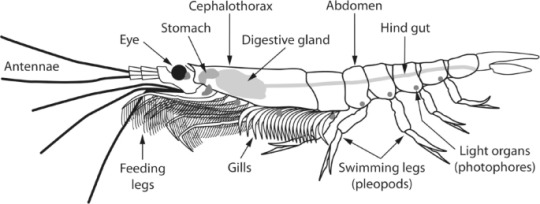
(Image: an anatomical diagram of a krill, with different external and internal body parts labeled. End ID. Source)
Krill are primarily filter-feeders that live in all oceans and in the shallow and deep seas. Most species feed on phytoplankton, especially diatoms, while other are omnivores or carnivores that hunt zooplankton and larval fish. The thoracic legs are covered in filamentous structures and will be held out in a formation called the feeding basket. Plankton passing through the basket will get caught and transferred to the mouth. Krill have a simple digestive tract with a two-chambered gut. The first chamber acts as a mill, crushing the hard shells of the diatoms to make digestion easier. Most krill practice diel vertical migration, a common ocean strategy where animals will remain at depth during the day and move closer to the surface at night. Some species remain in the deep sea all their lives. As krill feed, they become heavier and more sluggish and will sink, allowing the hungrier krill. Krill swim and feed in massive swarms.
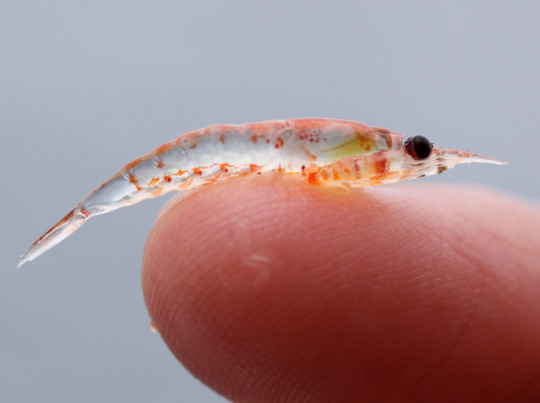
(Image: an antarctic krill balanced on a human finger, to show its size. It is barely longer than the first segment of the finger. End ID)
Krill are a vital part of ocean ecology. Energy is introduced to phytoplankton by the sun and used to produce the energy-storing molecule ATP. Krill eat the phytoplankton and convert that energy into a form larger animals can consume and digest. Whales can't gain energy from phytoplankton, but they can get that energy from krill. Krill are a vital food source for baleen whales, seals and sea lions, fish, squid, and other animals. By eating phytoplankton and then being eaten themselves, krill allow that energy to move through the entire food web. Krill also play a role in moving nutrients and carbon through the ocean. Carbon enters the ocean through runoff and carbon dioxide from the atmosphere entering the surface waters. Phytoplankton take in the carbon dioxide and covert it into forms of carbon that other organisms can use. The krill then eat the plankton, taking the carbon into themselves. Through feces, molted exoskeletons, and dead krill, that carbon can sink into the deep sea, where it can become sequestered in the sea floor. Similarly, nutrients can pass from krill to their predators or into the deep sea through feces and remains. Without krill and other animals filling similar roles, carbon and nutrients would have a much harder time reaching the deep ocean and larger animals wouldn't be able to access the energy stored in phytoplankton.

(Image: a diagram showing the highly complex process by which krill assist in moving carbon through the ocean. End ID. Source)
Being animals with exoskeletons, krill have to molt when they outgrow their current shells. Generally speaking, young krill will molt more often than older ones. Most crustaceans will slow down as they age, with each molt occurring further and further apart. This is not the case with krill, which keep molting at a relatively consistent rate through their lives. some species of krill can also get smaller after a molt instead of always getting bigger. This is used when food is unavailable, reducing the amount of energy the animal needs. Some species have been observed going 9 months between meals. Some species can spontaneously molt as a reaction to threats, leaving behind the empty exoskeleton as a decoy for predators.

(Image: a northern krill. It is similar to the antarctic krill, but with a different arrangement of pigment. End ID)
Krill typically mate seasonally, though some tropical species can mate year-round. A female can produce thousands of eggs, which can make up a third of her body weight during mating season. Being a major prey animal, krill need to reproduce rapidly to keep their populations up. Most species will mate and produce eggs multiple times per mating season. Males approach females and deposit sacs of sperm into their genital openings. The females then produce eggs which can be treated in two ways. Most species will release their eggs into the water column and provide no further care. 29 species instead attach their eggs to a sac held by the rearmost thoracic legs and carry them until the eggs hatch. Some of these species hatch at a more mature stage. Once the eggs hatch, they have to swim upwards to reach the photic zone of the ocean, where photosynthesis can take place. Larvae progress through several developmental stages. Like other crustaceans, they start as a napulus larva, though some sac-brooders will hatvch at the more advanced pseudometanapulus stage. Either way, they progress then to the metanapulus stage. At this stage, they can lo longer subside on yolk and must reach the photic zone and metamorphose into the calyptosis stage, the first stage with a mouth, before starving. The final larval stage is called the furcilia, which passes through a number of molts. During each molt, the abdomen will grow another segment and pair of swimmeretes. After the final furcilia stage, the krill will resemble a small adult. Krill life spans vary baes on species, from less than a year to 10 years, with species in colder water usually living longer. Relatively few krill will die of old age. In the antarctic krill, Euphausia superba, over half the population is eaten every year.

(Image: several stages of krill development form egg to napulus to more advanced larval stages that look like the adult. End ID. Source)
Krill conservation needs vary by species, but in general, they are highly abundant and in little danger of extinction. Krill are among the most abundant animals in the world, with antarctic krill having one of the largest total biomass of any animal. Monitoring the krill population is extremely important because of their importance to the global ecosystem. Krill have been fished commercially for centuries, used as food, bait, supplements, animal feed, and for shrimp paste and fish oil. Most krill fishing takes place around Antarctica as the krill there are highly abundant and seen as cleaner. As the krill fishery grows, more studies need to be done on the impact on the population and the other species that rely on them. Krill are also impacted by global climate change, ocean acidification, and pollution. Krill can ingest microplastics, which can then be passed onto whatever eats them. Krill are keystone species, meaning they are crucial to the health of their environments. If they go, massive parts of the ocean ecosystem will collapse.

(Image: someone holding a pile of dozens of krill in their hands. End ID)
#wet beast wednesday#biology#ecology#zoology#marine biology#animal facts#invertebrates#invertiblr#crustacean#krill#antarctic krill#informative#educational#image described
121 notes
·
View notes
Note
Totally for unrelated reasons, what are some more facts about communication drones? Like uhhh specific anatomy ect?
Prepare to get spammed with information! 👀
Communication Drones Infopost

Communication Drones (calling them CDs for short here) are a sub-type of Worker Drones fitted with antenna and special storage systems meant to analyze, store and transcrypt incoming and outgoing signals between Outposts, (human) landing pods and machinery.
CDs can also communicate with each other & Workers around them in a certain range which allows them to be very effective in sending out orders en masse to other Drones.
(more below the cut for their anatomy, specialities and more!)
Most CDs have two to four antennas fixiated to their head which are directly connected to their auditory entrance (or well, 'ears' as we would call it in human terms) which makes their antennas vital for their work and general hearing. Damaged or removed antennas may result in a CD losing their ability to hear or at least reduce it greatly.
Depending on the size of the antennas it's easy to see what purpose the CD served - long antennas are usually paired with long-range signals which put the individuals at use to distribute orders, arrange communication between ships & pods on their way to other exoplanets (when humans were still around) and to manage incoming signals from other planets & stations/outposts.
Short antennas usually indicated a more localized position for the drone in question - mainly within a singular Outpost or in ships to work directly connected to the local machinery and computers, sending orders in smaller ranged areas and storing security data.
Most CDs have secondary enhancers which work similar to a short-range antenna allowing them to switch between long and short range at will (mainly used for CDs that had flexible working places between ground & flight).
Generally, the antennas also function as "mood indicator". They can rotate around themselves and change position dependant on a fixed motion range around the head - similar to how e.g animals use their ears to indicate mood, CDs quickly took these habits from dogs that were around Copper-9 and video material of animals and copied them. Not all CDs did or do that, but alot of them do. For example if an individual is excited/attentive, the antennas would stick right up. If they're overwhelmed/annoyed/angry they'd usually be lowered down or pressed against the sides of the head.
They were expected to be very attentive and pay close attention to details. Their inner storage was designed to hold literal months and even years of auditory data that they recieved which was usually extracted every 4-6 months via the ports on their back which connected directly to the storage. Without these "clear outs" most CDs experience involuntary deletion of audio files which is out of their control and might result in them forgetting things they've heard/analyzed before.
Other than those two features their anatomy is fairly similar to that of normal Workers, height etc. as well.
After the humans disappearance alot of CDs lost their use as there... well, were no orders to share and no signals to analyze. Some of them struggled with this loss of "useability", some were fairly happy about this.
Lost/destroyed antennas cannot be restored by themselves (well, unless a CD is a Solver User like Kira) and CDs usually do not take well to losing or damaging antennas. Enhancers aren't as sensitive, but still hurt. Touching them might also cause disruption in hearing for CDs, it would be like someone rang a bell next to a humans ear for them. :'D (no touchie!)
CDs are generally connected to ECHO in the MD: Echo story (outside of that this plot point doesn't matter, just mentioning it here haha). Since Kira was the first CD Echo tried to use as host it developed an interested in them since CDs are great tools to be used for mass-ordering hosts.
Alot of CDs were destroyed while the humans were still around, especially if their warranty expired or they became damaged, to prevent sensitive information (such as orders and analyzed data) from leaking or being stolen by enemy forces/entities.
CDs infected with a Solver usually had enhanced auditory strenghts, capable of sending much stronger signals regardless of their antenna's natural range of reach - and they could also "ping" other Users & Hosts which makes them easy tools of manipulation. Luckily the only known CD which acted as AS Host was Kira who was "patched", so it couldn't spread for now (excluding Echo :'D)
#murder drones#communication drones#md: echo#murder drones: echo#murder drones oc#liti#hena#kylie#murder drones fanart#concept art#info post#md au#murder drones AU#murder drones fandom#my art
99 notes
·
View notes